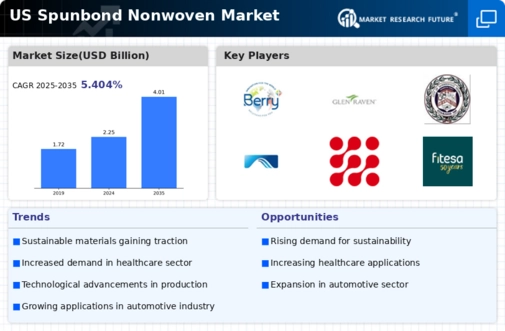US Spunbond Nonwoven Market Summary
The US Spunbond Nonwoven Market is projected to grow from 2.25 USD Billion in 2024 to 4.01 USD Billion by 2035.
Key Market Trends & Highlights
US Spunbond Nonwoven Market Key Trends and Highlights
- The market is expected to achieve a compound annual growth rate (CAGR) of 5.39 percent from 2025 to 2035.
- By 2035, the market valuation is anticipated to reach 4.01 USD Billion, indicating robust growth potential.
- In 2024, the market is valued at 2.25 USD Billion, reflecting a solid foundation for future expansion.
- Growing adoption of sustainable materials due to increasing environmental awareness is a major market driver.
Market Size & Forecast
| 2024 Market Size | 2.25 (USD Billion) |
| 2035 Market Size | 4.01 (USD Billion) |
| CAGR (2025-2035) | 5.39% |
Major Players
Berry Global, Glen Raven, Sandersville, M and G Group, Freudenberg, Tweave, Oriental Industries, Fitesa, KimberlyClark, Propex, DuPont, Glatfelter, Hollingsworth and Vose, Sioen





















Leave a Comment